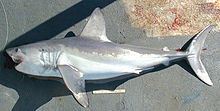
Back بربيجل Arabic بربيجل ARZ لامنا ناسوس AZB Селдова акула Bulgarian Soner (loen) Breton Marraix Catalan Lamna nasus CEB Žralok sleďový Czech Corgi Môr Welsh Sildehaj Danish
| Porbeagle | |
|---|---|

| |
| Scientific classification | |
| Domain: | Eukaryota |
| Kingdom: | Animalia |
| Phylum: | Chordata |
| Class: | Chondrichthyes |
| Subclass: | Elasmobranchii |
| Subdivision: | Selachimorpha |
| Order: | Lamniformes |
| Family: | Lamnidae |
| Genus: | Lamna |
| Species: | L. nasus
|
| Binomial name | |
| Lamna nasus (Bonnaterre, 1788)
| |

| |
Confirmed range Suspected range
| |
| Synonyms | |
|
Lamna philippii Perez Canto, 1886 | |
The porbeagle or porbeagle shark (Lamna nasus) is a species of mackerel shark in the family Lamnidae, distributed widely in the cold and temperate marine waters of the North Atlantic and Southern Hemisphere. In the North Pacific, its ecological equivalent is the closely related salmon shark (L. ditropis). It typically reaches 2.5 m (8.2 ft) in length and a weight of 135 kg (298 lb); North Atlantic sharks grow larger than Southern Hemisphere sharks and differ in coloration and aspects of life history. Gray above and white below, the porbeagle has a very stout midsection that tapers towards the long, pointed snout and the narrow base of the tail. It has large pectoral and first dorsal fins, tiny pelvic, second dorsal, and anal fins, and a crescent-shaped caudal fin. The most distinctive features of this species are its three-cusped teeth, the white blotch at the aft base of its first dorsal fin, and the two pairs of lateral keels on its tail.
The porbeagle is an opportunistic hunter that preys mainly on bony fishes and cephalopods throughout the water column, including the bottom. Most commonly found over food-rich banks on the outer continental shelf, it makes occasional forays both close to shore and into the open ocean to a depth of 1,360 m (4,460 ft). It also conducts long-distance seasonal migrations, generally shifting between shallower and deeper water. The porbeagle is fast and highly active, with physiological adaptations that enable it to maintain a higher body temperature than the surrounding water. It can be solitary or gregarious, and has been known to perform seemingly playful behavior. This shark is aplacental viviparous with oophagy, developing embryos being retained within the mother's uterus and subsisting on non-viable eggs. Females typically bear four pups every year.
Only a few shark attacks of uncertain provenance have been attributed to the porbeagle. It is well regarded as a game fish by recreational anglers. The meat and fins of the porbeagle are highly valued, which has led to a long history of intense human exploitation. However, this species cannot sustain heavy fishing pressure due to its low reproductive capacity. Direct commercial fishing for the porbeagle, principally by Norwegian longliners, led to stock collapses in the eastern North Atlantic in the 1950s, and the western North Atlantic in the 1960s. The porbeagle continues to be caught throughout its range, both intentionally and as bycatch, with varying degrees of monitoring and management. The International Union for Conservation of Nature (IUCN) has assessed the porbeagle as vulnerable worldwide, and as either endangered or critically endangered in different parts of its northern range.
- ^ Rigby, C.L.; Barreto, R.; Carlson, J.; Fernando, D.; Fordham, S.; Francis, M.P.; Herman, K.; Jabado, R.W.; Liu, K.M.; Marshall, A.; Pacoureau, N.; Romanov, E.; Sherley, R.B.; Winker, H. (2019). "Lamna nasus". IUCN Red List of Threatened Species. 2019: e.T11200A500969. doi:10.2305/IUCN.UK.2019-3.RLTS.T11200A500969.en. Retrieved 12 November 2021.
- ^ "Appendices | CITES". cites.org. Retrieved 2022-01-14.
© MMXXIII Rich X Search. We shall prevail. All rights reserved. Rich X Search
